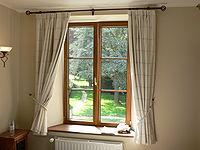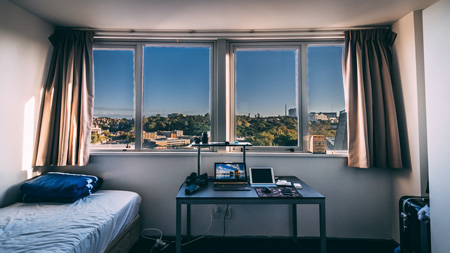Curtain and Drapery Glossary
A
Apron: Window molding located below the window sill on a window frame.
Arched Valance: A valance treatment that is arched along the lower edge.
Austrian Drape/Shade: A fabric window covering with soft draping scallops which run the length of the shade. A drape raised vertically in multiple scalloped sections with cords and rings.
Awning Windows: Windows which are hinged on top and swing outward to open. They are usually rectangular, and wider than they are long.
B
Balloon Shades: Fabric shades with deep inverted pleats that fall into airy, rounded poufs at the bottom.
Bay Window: A window area that extends outward from the main wall, forming an protrusion on the exterior of the home.
Bias: This term refers to the grain in fabric. The bias grain runs diagonally at a 45 degree angle to the straight grain and tends to stretch when pulled.
Bishop's Sleeve Curtains: Extra long curtain panels that are cinched up gathered up and over the cinched area.
Border: Found on Stage’s, similar to the teaser, a horizontal masking curtain, typically black.
Box Pleats: Deep, inverted, tailored pleats which are flat on the right side of the drapery to create a classical boxy look.
Brighton Shades: Similar to balloon shades, but without the pleats, rings, and cords along the sides. This allows the sides to fall in relaxed tails. The center section is usually wider than the sides.
Butterfly Pleats : A pleat with two, rather than three, folds to distinguish it from the basic pinch pleat.
C
Cafe Curtains: A window treatment that covers only the bottom half of a window. A cafe rod is most often hung at the halfway point of the window, at sash level.
Cascades: Side panels, usually pleated, which flank swags. They can be long or short.
Casement Window: A casement window has two verical sections that crank open outward.
Casing: A tunnel of fabric created by stitching parallel seam on folded fabric. A curtain rod is threaded through the casing.
Cathedral Window: These windows are usually seen in rooms with cathedral ceilings. The top of the window follows the slope of the ceiling. Many times the sloped top of the window is left bare.
Combination Rods: Two or three drapery rods sharing one set of brackets. They are used when installing draperies with sheers, or to create any layered look.
Commercial curtains: With the increase in single family homes during the last century, the curtain and drapery industries have witnessed simultaneous growth in the demand for their products. Commercial interests also grew during that time as many companies tried to supply institutions, hotels, etc. Commercial sized curtains are commonly used in restaurants, cinemas, and theater stages. From Wikipedia, the free encyclopedia (http://en.wikipedia.org/wiki/Curtain)
Contour Drape: A drape raised in multiple vertical sections with each section able to rise independently.
Cornice: A decorative wooden, fabric, or foam header placed above a window to conceal drapery hardware.
Curtain: A curtain (sometimes known as a drape, mainly in the United States, or drapery, mainly in the United Kingdom) is a piece of cloth intended to block or obscure light, or drafts, or water in the case of a shower curtain. Curtains hung over a doorway are known as portières. Curtains are often hung on the inside of a building's window to block the travel of light, for instance at night to aid sleeping, or to stop light from escaping outside the building (stopping people outside from being able to see inside, often for privacy reasons). In this application they are also known as "draperies." Curtains come in a variety of shapes, materials, sizes, colors and patterns, and they often have their own sections within department stores, while some shops are completely dedicated to selling curtains.
Curtains vary according to cleanability, ultraviolet light deterioration, oil and dust retention, noise absorption, fire resistance, and life span. Curtain may be moved by hand, with cords, by press-button pads or remote-controlled computers. Measuring the curtain size needed for each window varies greatly according to the type of curtain needed, window size, and type and weight of curtain.
An adaptation of the curtain may be a blind or, in warmer countries, wooden Window shutter that are fixed to the outside of the building to provide privacy and still keep the building cool inside. Curtains are a form of window treatment, and complete the overall appearance of the house. Window treatment helps control the ambiance and flow of natural light into the room. The effect of drapery or curtains, is best seen in daylight, and with proper indoor light positioning, it can look attractive even at night.[1]
Light control and insulation
Curtains can be made from varying thicknesses of fabric, each with a differing degree of light absorption and heat insulating qualities. For maximum temperature control, the curtain gap to the window should be small, with minimum convection drafts below or above the curtain. Various architectural structures around the curtain can minimize these air drafts.
A sheer or net curtain is one that is made from translucent fabric, such as a loosely woven polyester voile or a cotton lace. Sheer curtains allow a majority of light to be transmitted through the fabric, with the fabric weave providing a basic level of UV protection while retaining maximum visibility through the curtain. Sheer curtains are sometimes referred to as privacy curtains in reference to their screening abilities; during the day most sheer fabrics will allow people inside the home to see the outside view whilst preventing people outside the home from seeing directly into the home. Due to the loose weave in sheer fabrics, these types of curtains offer very little in the way of heat insulation.
Uncoated fabrics provide the next level of heat insulation and light absorption. Uncoated fabrics constitute the vast majority of fabrics used in curtains, and are composed of a tightly woven fabric, most typically a cotton/polyester blend, which is mostly opaque when viewed in ambient light. Uncoated fabrics provide a reasonable level of heat insulation due to the tight weave of the fabric, however the fabric itself is typically not thick enough to completely absorb strong light sources. As a result, when curtains made from uncoated fabrics are closed in an attempt to block out direct sunlight, light will still be visible through the curtain.
Coated fabrics consist of a standard uncoated fabric with an opaque rubber backing applied to the rear of the fabric to provide improved light absorption. To create a coated fabric a liquefied rubber polymer is applied in a single coat to an uncoated fabric and subsequently fused dry by means of a heated roller, in much the same way that a laser printer applies toner to a sheet of paper before fusing it dry. A fabric that has been through the coating process once is considered a 1 pass coated fabric, anecdotally referred to as dim-out or blackout because of the fabric's ability to absorb approximately 50-70% of a direct light source. To improve the light absorption of a fabric it is possible to re-coat a fabric up to a maximum of 3 pass coated, which is considered sufficient to block out 100% of a direct light source, hence such fabrics are referred to as blockout coated.
Maximum light absorption and heat insulation in a curtain is created through a lined curtain, which typically consists of an uncoated fabric at the front to provide the look and feel of the curtain, with a separate coated fabric attached at the rear to provide the insulative qualities. The coated fabric is typically referred to as a lining, which simply refers to a coated fabric that does not have any particular color or pattern.[citation needed]
Curtains may be held back with tie-backs or may be closed and opened with sticks called draw-pulls or curtain rods which are attached either to the runner or to the first hook. On some curtain rails/poles, there is pulley system for opening and closing called corded curtain tracks. The knobs at the end of these cords are called cord pulls or acorns. From Wikipedia, the free encyclopedia (http://en.wikipedia.org/wiki/Curtain)
Cyclorama: Found on Stages, a/k/a "cyc" or "sky drop," once referred to as a u-shaped curtain that was the last setting on stage. Typically a flat white or light blue color and generally the last curtain lit as the sky background.
D
Draw Draperies: Draperies which hang from a traverse rod and can be drawn to open or closed over the window by means of a cording system.
Double Fullness: Using fabric that is twice the measured width of the window. Double fullness creates a fuller look and that is more pleasing to view than skimpy fabric.
Drapery: a general word referring to cloths or textiles (Old French drap, from Late Latin drappus[1]). It may refer to cloth used for decorative purposes – such as around windows – or to the trade of retailing cloth, originally mostly for clothing, formerly conducted by drapers.

From Wikipedia, the free encyclopedia (http://en.wikipedia.org/wiki/drapery)
Drop Cloth: Drop curtain, Drop: a curtain that can be lowered and raised onto a stage from the flies; often used as background scenery.
Dowel: A round of unfinished wood that is available in many lengths and sizes. Dowels can be used as inexpensive curtain rods, and can be painted, stained, or fabric-covered, and finished with finials on each end. Draping: A technique of looping and securing fabric in graceful curves and folds.
E
Envelope Shades: Casual curtains attached to a mounting board and hung as a pair of flat panels. The bottom inside corners are pulled out and hooked onto the wall.
Eyelet/Eyehole: a small hole (usually round and finished around the edges) in cloth or leather for the passage of a cord or hook or bar
F
Facing: The strip of fabric that is sewn to the raw edge of a fabric and folded back to the wrong side.
Fan Shades: Arcs of fabric pulled together in the center by cords and rings fastened to the back of the shades. The arc, or fan, faces down. When lowered, the shade becomes a flat panel.
Fan Curtains: The same as the fan shade, but used on half circle windows with the fan facing up. A curved curtain rod is required to install fan curtains.
Festoon : a curtain of fabric draped and bound at intervals to form graceful curves. See also Swag
Finial: A decorative piece attached to the ends of drapery rods. Usually made of wood or metal and can be many sizes and shapes.
Finish: Product applied to fabric as a protection against water marks and fading.
Fire retardant fabrics: textiles that are naturally more resistant to fire than others through chemical treatment or manufactured fireproof fibers.
Terminology and test limitations
The term fire retardant as applied to organic (i.e., containing carbon) materials, is intended to refer to reduced fire hazard, as all will burn under certain circumstances. The tests used specified in building codes, such as NFPA 701, are more correctly flame resistance tests, which test a fabric's ability to resist ignition with the flame size and duration in the test conditions[1]. The result is a comparative test, which provides a measure of the material's resistance to propagating combustion caused by small scale ignition sources. These tests do not predict the burning characteristics of full scale hazards. In many cases, if exposed to a sufficiently large and sustained exposure fire, the fire retardant fabrics will burn vigorously.
Fire retardant fabrics and stage drapery
Fabric flammability is an important textile issue, especially for stage drapery that will be used in a public space such as a school, theater or special event venue. In the United States, Federal regulations require that drapery fabrics used in such spaces be certified as flame or fire retardant. For draperies and other fabrics used in public places, this is known as the NFPA 701 Test, which follows standards developed by the National Fire Protection Association (NFPA). Although all fabrics will burn, some are naturally more resistant to fire than others. Those that are more flammable can have their fire resistance drastically improved by treatment with fire retardant chemicals.
Fabric choices and fire retardance
Stage curtain fabric choices are numerous, depending on the required style of curtain.
Fire retardancy fabric treatment
The flammability of fabric can be drastically reduced through the use of fire retardants. Many natural fibers, including cotton, can be topically treated with a chemical that reduces the fabric’s flammability to the extent that it becomes nearly non-combustible. During a fire, the chemical reacts with the gases and tars generated naturally by the fabric, converting the gases and tars to carbon char, thus drastically slowing the fabric’s burning rate.
Some polyester fabrics are considered permanently fire retardant. This is because fire retardant properties are built directly into the molecular structure of the fibers. Fabrics manufactured utilizing Trevira and Avora polyester fibers are considered inherently or permanently fire retardant. Other synthetic fabrics may be considered durably fire retardant, fire retardant, or non-fire retardant. Durably fire retardant refers to a process in which polyesters are chemically treated during the manufacturing process with a non-water soluble chemical. In other cases, synthetic fabrics may be topically treated with chemicals after the manufacturing process (in the same manner as natural fibers such as cotton), or may be untreated (or untreatable) and therefore considered non-fire retardant.
Aramid, like Twaron is used in modern fabrics to withstand high temperatures in industry and fire-fighting.
Durability and cleaning of fabric and drapes
When a fabric is designated as inherently fire retardant, permanently fire retardant, or durably fire retardant, the flame retardancy will last for the life of the fabric. The drapery can be laundered or dry-cleaned as recommended by the drapery manufacturer. In the case of fabrics that are designated as fire retardant, that have been topically treated with chemicals, the flame retardancy of the fabric will dissipate over time, particularly with repeated cleaning. These fabrics must be dry-cleaned with a non-liquid cleaning agent.
Typically, the flame retardancy of topically treated fabric is certified for one year, though the actual length of time in which the treatment remains effective will vary based on the number of times the drapery is dry-cleaned and the environmental conditions in the location in which the drapery is used. It is recommended that topically treated drapery be re-tested for fire retardancy on an annual basis and re-treated by a qualified professional as needed.
References
- ^ NFPA 701,D1.1
External links
- National Fire Protection Association
- California State - Office of the State Fire Marshal
- Navigating Flame Retardancy Regulations in the US
- Fire Retardancy Definitions including the NFPA 701 Test
Retrieved from "http://en.wikipedia.org/wiki/Fire_Retardant_Fabrics"
French Door : A door with with rectangular panes of glass extending the full length. Usually hung with a pair of doors in one frame, with both doors opening outward.
Fringe: A decorative trim sewn onto the edges and hems of curtain panels and rugs. Also often used to decorate pillows and lampshades.
Frontal: a drapery that covers the front of an altar
Fullness: Refers to the width of the fabric in relation to the curtain rod. Most window treatments are two to three times fullness.
G
H
Header: The top edge of a rod-pocket curtain that forms a ruffle when the curtain is on the rod.
Hopper Windows : These windows are hinged at the bottom and open inward from the top - the reverse of awning windows.
I
J
Jabot: Piece of fabric, long or short, which drape down on either side of a swag or valance, often pleated and tapered.
K
Kick Pleated Valances: Constructed like box pleats, but the pleats are spaced further apart.
Knotting: A technique used when looping and arranging fabric panels.
L
Lambrequins: Eleborate cornices, usually made of wood, which extend all or part of the way down the sides of the window. They are often padded and upholstered.
Legs: On Stages, narrow vertical curtains used in conjunction with the draw curtain, normally black, to mask the offstage areas from the audience view.
Lining: Fabric used as a backing for drapery panels. Lining can provide body and fullness, light control, and privacy. Often lining fabrics are decorative and chosen to be a pleasing contrast to the drapery fabric.
M
Main Draw: On a Stage, the Front Curtain a/k/a "main," "act," or "grand drape," the first draw of bi-parting curtain on stage that is typically colored.

Red Main Draw Curtains are common on stages
Mounting Board: A wooden board installed either inside or outside the window frame to which some types of window treatments are attached.
Mullion: Wood trim that sets off smaller panes of glass in a window.
N
Nap A fabric with a texture or design that runs on one direction such as corduroy and velvet. A fabric with a nap will often look different when viewed from various directions. When using a fabric with a nap, all peices must be cut and sewn together so the nap runs in only one direction.
O
Olio Curtain: On Stages, A/K/A "in-one-act curtain," an older term for a colored draw curtain or painted drop, located several feet upstage of the front curtain. Many older Broadway shows were structured to have a small scene in front of the olio while a major set change occurred upstage.
Overlap: The area where drapery panels lap over each other at the center of a two-way traverse rod.
P
Passementerie: Fancy edgings or trims which emphasize the shape of the curtain, such as fringe, tassels, braid, and ruffles. Plinth: A square of decorative wood installed at the corners of a window frame.
Puddled Curtains: Curtains with long side panels allowed to drape and puddle onto the floor to create a soft, full look.
Portier: a heavy curtain hung across a doorway
Projection: The distance from the front of the drapery rod to the wall on which it is mounted.
Q
R
Railroading: Refers to using fabric horizontally rather than vertically. Fabric without a nap or a directional design can be railroaded easily. Used to avoid seams in long lengths of fabric (as in dust ruffles).
Repeat: How often the pattern is duplicated at intervals down the fabric or wallcovering. One repeat is one full pattern.
Return: The portion of the drapery extending from the corner of the rod to the wall, enclosing the brackets of the drapery hardware.
Right Side: The printed side of the fabric that is used as the finished side of an item. The right side generally has the most color and the most finished look to it.
Rings: Rings of wood or plastic are hooked or sewn to the top edge of a curtain and these rings are then threaded through the curtain rod.
Rod Pocket Curtains: The most common window treatment. A stitched pocket at the top of the curtain is gathered or shirred onto a curtain rod.
Roller Shades: Shades made of vinyl or fabric attached to spring rollers, mounted to the inside window casing or the window frame.
Roman Shades: Drawn up from the bottom by means of cords and rings, these shades create horizontal folds when raised. A roman shade panel is flat when lowered and covers the window glass completely.
Ruching: Extremely tight gathers used as a decorative top finish to a panel.
S
Scrim: On Stages, a curtain of an open weave sharkstooth fabric that can be seen through only when backlit with the audience side of the curtain dark. Becomes opaque when the audience side is lit and the backlight is removed.
Self-Styling Tape: A stiff tape with woven-in cords used to create pleated and shirred curtains.
Selvage: The selvage edges of fabric are the finished sides of the lengthwise grain.
Sheer: A drapery panel made of sheer or translucent fabric, sometimes used underneath an outer drapery.
Shower Curtain: a curtain that keeps water from splashing out of the shower area
Shirred Curtains: Curtains stretched tightly and gathered on rods at both the top and the bottom.
Stackback (or stacking space) : The area of the wall where drapery comes to rest when it is opened and the window is exposed. Draperies are sometimes installed so that the stackback clears the window frame, allowing an unobstructed view.
Stagecoach Valance: Used on narrow windows, this is a panel of fabric mounted on a board, and attached to the inside frame of the window. It is rolled up and tied in the center with a ribbon.
Straight Grain: The lengthwise threads of the fabric, running parallel to the selvages.
Surround Curtain: Sometimes referred to as a cyclorama, a setting of pleated curtains in a u-shape, typically used in elementary schools to reduce costs.
Swag : One or more pieces of fabric draped over a rod, typically used at the top of a window treatment with jabots. Also known as a festoon.
T
Tab-Top Curtains: Curtains with fabric bands attached to the top into which a decorative curtain rod is inserted.
Tormentors: a/k/a "torms," similar to legs, placed downstage of the front curtain to size the width of the stage opening.
Traveller: Draw Curtain on Stage a/k/a "traveler," "mid," or "rear," a term referring to a bi-parting curtain upstage of the front curtain.
Teaser: Similar to the valance, a flown horizontal curtain that sizes the stage opening.
Tension Rod: A curtain rod which stays in place inside the window frame through spring tension.
Tie-Tab Curtains: Similar to tab-top curtains, but with ribbons or fabric bands tied over the rod, instead of sewn in place.
Tiebacks : Fabric bands, cords, or other material that shape the curtain or drape and holds them back from the window.
Traverse Rod: Adjustable drapery rods that open and close the window treatment by pulling a cord.
Trim: Decorative cording, braids, or fringes applied to the edges or hems of draperies, to match or contrast the panel fabric.
Triple Fullness: A fabric panel that is three times the width of the window. Often sheers and lightweight curtains are made in triple fullness.
U
V
Valance : A short horizontal window treatment that covers the top of the window and the drapery hardware. A valance is made of matching or contrasting fabric, often with a casing at the top, and gathered onto a curtain rod.
Velcro: Hook and loop tape used for attaching fabric to a mounting board. Sometimes used for lightweight fabrics and valances.
Venetian Blinds: Blinds made of metal or wooden slats, attached to cloth tape, and worked by a cord on a pulley system, and available in many widths, colors, and sizes. Blinds provide excellent light control while allowing some view to the outside.
W
Warp and Weft: Refers to the direction threads in a fabric. Warp threads run the length of the fabric. Warp threads are crossed by the weft threads that run from selvage to selvage across the width of the fabric.
Window Scarf: A long piece of fabric casually draped over a pole or rod at the top of a window like a valance. The center is gently pulled down to create a soft curve.
Wrong Side: The back of the fabric. The less finished side that may have stray threads or a more rough look to it.
X
Y

